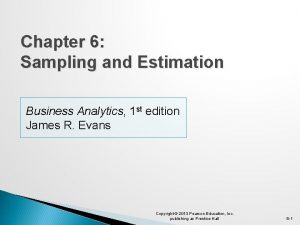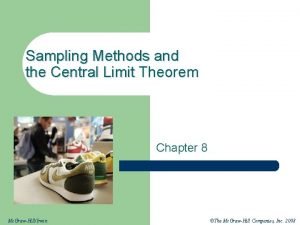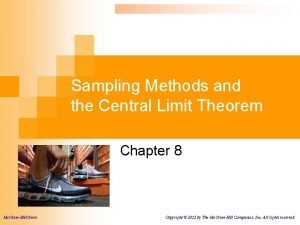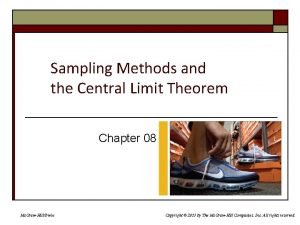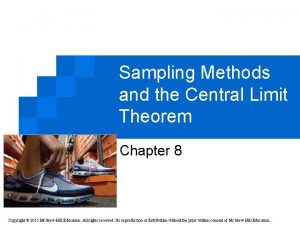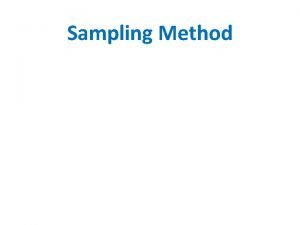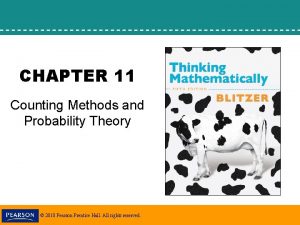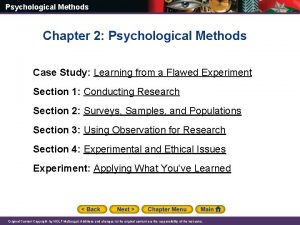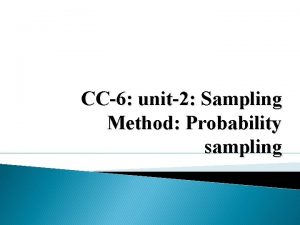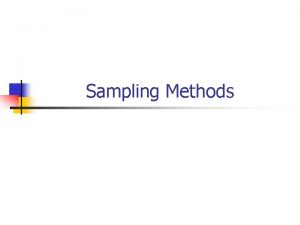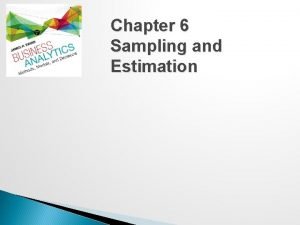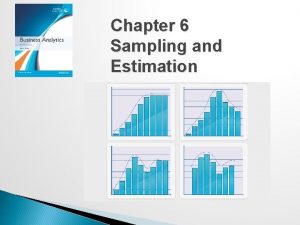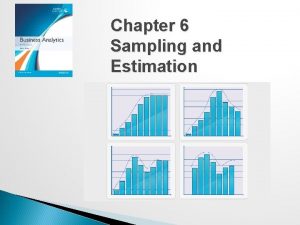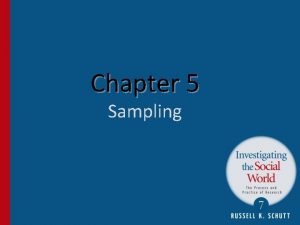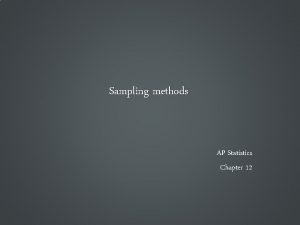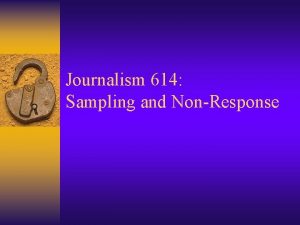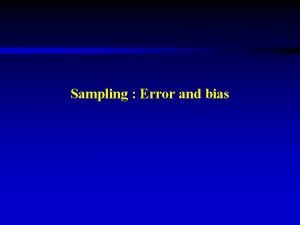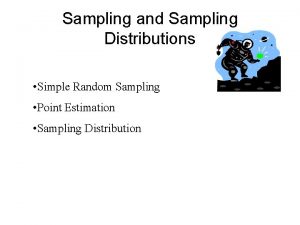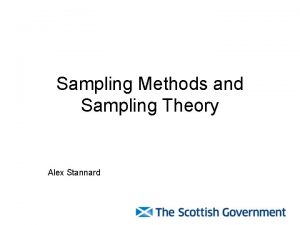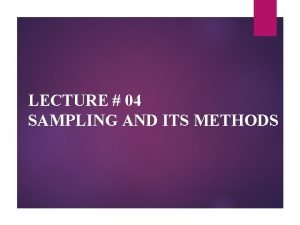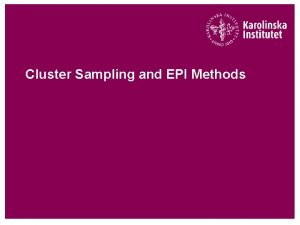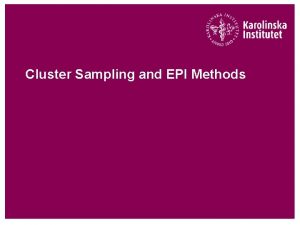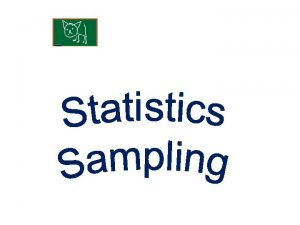Chapter 8 SAMPLING and SAMPLING METHODS SAMPLING If
























- Slides: 24

Chapter 8 SAMPLING and SAMPLING METHODS

SAMPLING • If the data you collect really are the same as you would get from the rest, then you can draw conclusions from those answers which you can relate to the whole group. • This process of selecting just a small group of cases from out of a large group is called sampling.


The need to sample Sampling- a valid alternative to a census when; • A survey of the entire population is impracticable • Budget constraints restrict data collection • Time constraints restrict data collection • Results from data collection are needed quickly

When doing a survey, the question inevitably arises: • how representative is the sample of the whole population, in other words; • how similar are characteristics of the small group of cases that are chosen for the survey to those of all of the cases in the whole group?

Population in Research • It does not necessarily mean a number of people, it is a collective term used to describe the total quantity of things (or cases) of the type which are the subject of your study. • So a population can consist of certain types of objects, organizations, people or events.

Sampling Frame • Within this population, there will probably be only certain groups that will be of interest to your study, this selected category is your sampling frame.

Populations can have the following characteristics: Characteristics Explains Examples homogeneous all cases are similar bottles of beer on a production line stratified contain strata or layers people with different levels of income: low, medium, high proportional stratified contains strata of known proportions percentages of different nationalities of students in a university grouped by type contains distinctive groups of apartment buildings – towers, slabs, villas, tenement blocks grouped by location different groups according to where they are animals in different habitats – desert, equatorial forest, savannah, tundra

SAMPLING METHODS

Sampling techniques

ü Probability sampling techniques give the most reliable representation of the whole population. ü Non-probability techniques, relying on the judgment of the researcher or on accident, cannot generally be used to make generalizations about the whole population.

Probability Sampling • It is a sampling technique in which sample from a larger population are chosen using a method based on theory of probability. • For a participant to be considered as a probability sample, he/she must be selected using a random selection. • The most important requirement of probability sampling is that everyone in your population has a known and an equal chance of getting selected. • Probability sampling uses statistical theory to select randomly, a small group of people (sample) from an existing large population and then predict that all their responses together will match the overall population.

Types of Probability Sampling Four main techniques used for a probability sample: Ø Simple random Ø Stratified random Ø Cluster Ø Systematic

Simple random sampling • As the name suggests is a completely random method of selecting the sample. This sampling method is as easy as assigning numbers to the individuals (sample) and then randomly choosing from those numbers through an automated process.

Stratified Random sampling • Iinvolves a method where a larger population can be divided into smaller groups, that usually don’t overlap but represent the entire population together. While sampling these groups can be organized and then draw a sample from each group separately. A common method is to arrange or classify by sex, age, ethnicity and similar ways.


Cluster random sampling • It is a way to randomly select participants when they are geographically spread out. Cluster sampling usually analyzes a particular population in which the sample consists of more than a few elements, for example, city, family, university etc. The clusters are then selected by dividing the greater population into various smaller sections.


Systematic Sampling • It is when you choose every “nth” individual to be a part of the sample. For example, you can choose every 5 th person to be in the sample. Systematic sampling is an extended implementation of the same old probability technique in which each member of the group is selected at regular periods to form a sample. There’s an equal opportunity for every member of a population to be selected using this sampling technique.

Types of Non-probability Sampling Four main techniques used for a non-probability sample: Ø Convenience Ø Judgemental Ø Snowball Ø Quota

Convenience Sampling • It is a non-probability sampling technique used to create sample as per ease of access, readiness to be a part of the sample, availability at a given time slot or any other practical specifications of a particular element. • Convenience sampling involves selecting haphazardly those cases that are easiest to obtain for your sample, such as the person interviewed at random in a shopping center for a television program.

Judgmental Sampling • In the judgmental sampling, also called purposive sampling, the sample members are chosen only on the basis of the researcher’s knowledge and judgment. • It enables you to select cases that will best enable you to answer your research question(s) and to meet your objectives.

Snowball Sampling • Snowball sampling method is purely based on referrals and that is how a researcher is able to generate a sample. Therefore this method is also called the chain-referral sampling method. • This sampling technique can go on and on, just like a snowball increasing in size (in this case the sample size) till the time a researcher has enough data to analyze, to draw conclusive results that can help an organization make informed decisions.

Quota Ssampling • Selection of members in this sampling technique happens on basis of a pre-set standard. In this case, as a sample is formed on basis of specific attributes, the created sample will have the same attributes that are found in the total population. It is an extremely quick method of collecting samples. • Quota sampling is therefore a type of stratified sample in which selection of cases within strata is entirely non-random.
 Sampling and estimation methods in business analytics
Sampling and estimation methods in business analytics Sampling methods and the central limit theorem
Sampling methods and the central limit theorem Sampling methods and the central limit theorem
Sampling methods and the central limit theorem Sampling methods and the central limit theorem
Sampling methods and the central limit theorem Limit sample
Limit sample What is the sample size in qualitative research?
What is the sample size in qualitative research? A-wax pattern recognition
A-wax pattern recognition Snowball sampling
Snowball sampling What are the sampling methods in psychology
What are the sampling methods in psychology Audit sampling methods for tests of controls
Audit sampling methods for tests of controls Sampling methods statistics
Sampling methods statistics Julias ceasar
Julias ceasar Sampling method in research
Sampling method in research Convenience sampling example situation
Convenience sampling example situation What is stratified sampling
What is stratified sampling Contoh time sampling dalam observasi
Contoh time sampling dalam observasi Stratified sampling vs cluster sampling
Stratified sampling vs cluster sampling Convenience sampling images
Convenience sampling images Natural sampling vs flat top sampling
Natural sampling vs flat top sampling Chapter 11 counting methods and probability theory answers
Chapter 11 counting methods and probability theory answers Chapter 19 methods of therapy
Chapter 19 methods of therapy Chapter 2 psychological methods
Chapter 2 psychological methods Scientific methodswhat is a hypothesis?
Scientific methodswhat is a hypothesis? Psychology principles in practice
Psychology principles in practice Research methods for business students chapter 5
Research methods for business students chapter 5
